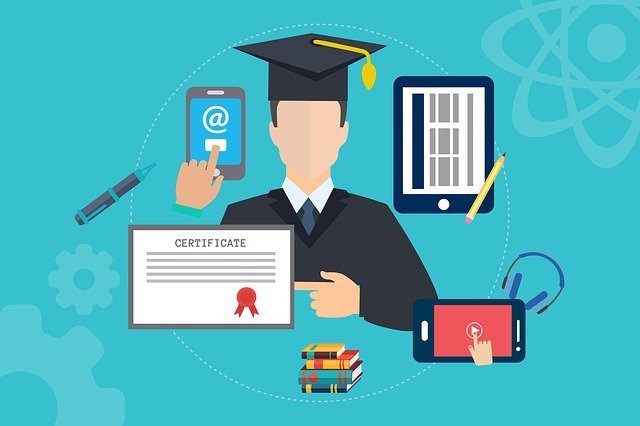How technology has changed online education
5 min read
Last Updated on January 15, 2022 by Aaron Thompson
How technology has changed online education
How technology has changed online education The idea of ?? standing in the library for hours, looking for a particular book isn’t as appealing as it used to be—nor is it even necessary for most of us.
Technology has made information-sourcing a lot easier, and e-libraries are perfect examples of how technology has improved education.
As a student, you need technology to get the resources to write academic essays. To learn how to write a cause and effect essay or another letter, you can find valuable material through a quick Google search.
Decades ago, it was not that easy. But nowadays, you can find all the information you need to write your articles in just a few clicks. That is the power of the Internet – the greatest achievement of technology.
A free online course in artificial intelligence
When a Stanford University professor offered a free online course in artificial intelligence, he had no idea that the experiment would attract 160,000 students from 190 countries and create a wave of hype.
This is one of many examples of how technology is reshaping education around the world. From the rapid proliferation of massively open online courses, or MOOCs,
To the widespread use of mobile devices that support a variety of “blended learning” models (part online, part brick-and-mortar based), technology is new.
creating challenges and many new opportunities for all types of educational institutions from elementary education to universities.
“Technology is changing the dynamics of education, particularly the relationship between teachers and students.
As teachers begin to rethink the learning experience, we believe the educational tools to support this growth Reshaping places will also be important,” said Andrew Kim, a Steelcase Workspace Futures researcher and member of the Steelcase
Education Solutions team, which is investigating the spatial implications of learning and technology. So far, the study included students in 20 schools and Includes observation and interviews of teachers.
Everywhere there is a place to learn
Discover how Steelcase Education works with educational institutions to create the most effective, rewarding and inspiring learning environments.
Among the fastest-growing and irreversible trends at all levels of education: the increasing use of laptops, tablets and other mobile devices.
Many elementary schools now provide each student with a laptop or tablet. In colleges and universities, many undergraduates now carry tablets as well as laptops. advantages and disadvantages of mobile phones essay
Always interested in the benefits of portability, an increasing number are now demanding content delivered on their smartphones.
As recently as a few years ago, mobile devices were used almost exclusively as merely a souped-up alternative to traditional devices such as handouts, overhead projectors, transparencies for books, paper, and pens.
Today, however, these technologies are beginning to change how instruction and learning actually take place.
technology to replace the old model of standardized
Teachers are using technology to replace the old model of standardized, rote learning and create more personalized, self-guided experiences for their students.
There is greater multi-device synchronization with software that supports multi-user collaboration and greater support for virtual conversations, both in and out of the classroom.
And more students and teachers are creating their own digital content, including animations and videos.
Whether we like it or not, technology has dramatically affected our society. From manufacturing to medicine, it has provided innovations that ease our daily activities and make life more convenient.
Because of its benefits, people continue to incorporate technology into various aspects of their lives. This is particularly evident in the field of education.
When the Internet and computers were first introduced to the world, they were not accessible to everyone. In addition, they were too expensive to use in schools and classrooms. Until now, they still seem like a luxury to many.
But they cannot ignore the benefits that these technologies can bring to the teaching-learning process. This is why schools work with a variety of partners and stakeholders to bring available technologies into their classrooms.
In this article, you will learn about the different ways in which technology becomes beneficial in education. How to get rid of maggots on animals at home.
While the shift to distance learning during the pandemic caused many headaches for K-12 schools and colleges, it’s hard to imagine how most of them would have given any instruction had it not been through technology.
Most school decision-makers flipped a switch overnight in an unwavering commitment to their communities to instruct remotely. Isn’t it better to just wait for the pandemic?
And yet, not surprisingly, much of the conversation in academia focuses on the disadvantages of technology. Does Virtual Learning Really Work?
Are students spending too much screen time?
Are we becoming increasingly dependent on technology in the classroom? “Why are some children thriving during distance learning?” It’s refreshing to come back to articles like that. Or “Distance Learning: Boosting College-, Career-, and Life-Readiness” which celebrate the fact that technology is enhancing education.
Change can certainly be a catalyst for positivity and necessity always leads to innovation, so let’s consider some of the ways technology has shaped education positively:
In the past, students mostly relied on their teachers and textbooks as their primary sources of information. They learn from what they hear and read.
However, that setup has changed since the beginning of the Internet. Nowadays, everyone can easily get the information they need by using search engines like Google.
learn new things from different sources
This means that his ability to learn new things from different sources somehow became limitless.
In addition, great progress can be made in the field of research thanks to the Internet. Students and professionals can collect information and related literature more easily than ever before.
In this situation, technology helps to discover new things and improve our quality of life in education, medicine and other fields.
Finally, the impact of technology on education is so tremendous that it can no longer be taken away. Current innovations have provided greater accessibility, greater flexibility and better student engagement.
In addition, he contributed in terms of online testing, learning materials and communication. Despite all these advantages, we should try to use the available technologies for better, not for worse.






